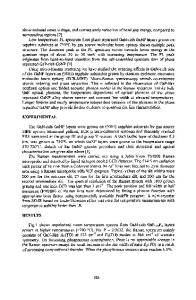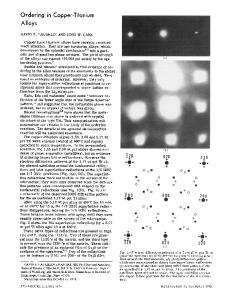Ordering in Binary and Ternary Alloys
- PDF / 826,374 Bytes
- 6 Pages / 415.8 x 637.2 pts Page_size
- 22 Downloads / 348 Views
ORDERING IN BINARY AND TERNARY ALLOYS M. FAYARD Centre d'Etudes de Chimie Mdtallurgique 15, France
rue G. Urbain,
94400 VITRY/Seine
The most interesting topics to be solved during the next years, in the field of short-range order and of ordering transitions is the accurate determination of pair interaction parameters, or more generally interactions in the case of higher order configurations. In fact, there are a number of papers in this conference devoted to this problem. Here, I would like to emphasize two aspects of this problem. The first one concerns the range of pair correlations in short range ordered alloys and the second with simultaneous ordering and segregation, which requires both diffuse scattering measurements and also small angle scattering measurements. I would like to illustrate the former with three examples of work on short-range order in Ni 3 Fe and with recent results on Au 3 Cu. For Ni 3 Fe these are the observation of dislocation pairs by transmission electron microscopy, the field ion microscope results of Taunt and Ralph [1,2] and finally the diffuse neutron scattering measurements of Lefebvre et al. [31, together with the computer simulations. When we began studying ordering in permalloys with Y. Calvayrac [41, we found that the head of a dislocation pile up consisted of paired dislocations 2 . This was for a short-range ordered alloy. We observed that the distance between dislocation pairs increased with distance from the head of the pile up and that after the third pair, only isolated single dislocations occurred. This means that the glide plane was then disordered and that subsequent glide will not change the degree of local order and hence the configurational energy. In this way, we can evaluate roughly the range of correlation and for three pairs this is equal to 6 b (b is the Burgers vector) that is a . This is indeed a surprisingly large distance. More recently Lefebvre et al. [3] have measured the neutron diffuse scattering of a 62Ni 3 Fe single crystal quenched from different temperatures. As a result of 62 i) the strong contrast between Ni and natural Fe, ii) the very low background intensity, iii) the small size effect, the measurements are very accurate and, for example, aOOO is very close to unity. The measured Waren-Cowley a parameters have the same sign variation as for ordered L1 2 up to X3 4 . These measurements were made on quenched alloys but recent work has shown that the diffuse scattering is not significantly modified if the measurements are carried out at a temperature above the critical temperature (Lefebvre et al. this conference). If we wish to reconstruct the diffuse scattered intensity from the measured a parameters, we find that it is necessary to include a very large number of parameters in the synthesis. Figure 1 shows the measured diffuse intensity between 100 and 110, and also the synthesised intensity using 9 and 33 short-range order parameters. Even with 33 parameters, it is not possible to fit the observed intensity at the exact superstructure position
Data Loading...










